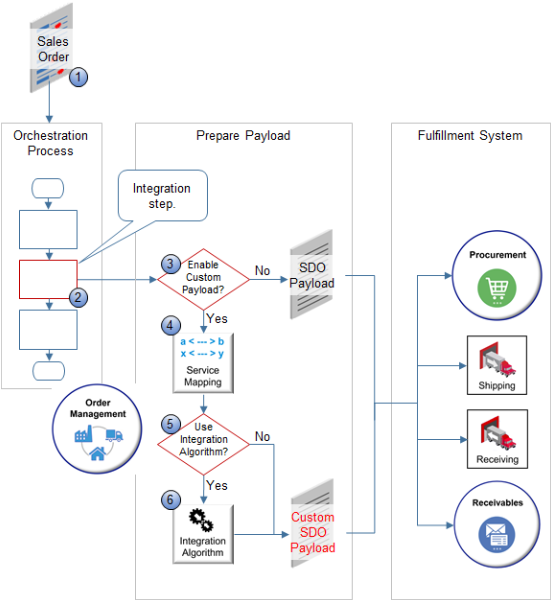Overview of Integrating Order Management with Other Oracle Applications
Integrate Order Management to send details to some other Oracle application.
Use a predefined attribute to send details, or create an extensible flexfield in Order Management to store them, then map it to some other Oracle application.
For example:
|
Oracle Application |
Description |
|---|---|
|
Oracle Receivables |
|
|
Oracle Procurement |
Create an extensible flexfield on a fulfillment line in Order Management to capture the price for the item. You can send the price that you negotiate with your supplier to the purchase request in Oracle Procurement. Order Management comes predefined to send a set of attributes to your fulfillment system for a purchase order in a drop ship flow. You can use a service mapping to send an attribute that isn't predefined. For example, send a price that you negotiate with your supplier during drop ship, or send a deliver-to address to your supplier during drop ship. |
|
Oracle Receiving |
Create extensible flexfields on the fulfillment line in Order Management to capture lot details and serial details. Send these details to the receiving request in Oracle Receiving. |
|
Oracle Shipping |
|
How it Works

Note
-
Capture order details, such as in a sales order that you create in Order Management.
-
Use a predefined task type in the integration step of your orchestration process to send details to your fulfillment system.
-
Did you enable the Enable Custom Payloads for Downstream Integration feature?
Enabled
Description
Yes
Use the service mapping. You can set up the payload to integrate with your fulfillment systems.
No
Use the predefined SDO payload (service data object) and proceed to fulfillment. For an example that uses an SDO, see Include Price, Discounts, and Shipping Charges in Your Payloads.
-
Call the service mapping that you set up that maps attributes between Order Management and your fulfillment system.
-
Did you create an integration algorithm?
Created an Integration Algorithm
Value
Yes
Call it. Use the integration algorithm to do more complex logic, as necessary.
No
Use only the service mapping to create the payload.
-
Use the service mapping and the integration algorithm to create the payload.
Note
-
You set up an integration algorithm and a service mapping when you create the integration.
-
An integration algorithm uses logic that's similar to a pricing algorithm.
-
A service mapping that you set up for an integration uses logic that's similar to the service mapping that you set up for pricing.
-
You use the Pricing Administration work area to set up the integration algorithm and the service mapping that you use for integration. However, your service mapping and integration algorithm are completely separate from Pricing. You use Pricing Administration only to leverage some of the logic that Pricing uses for its service mappings and integration algorithms.
-
An integration algorithm and the service mapping that you set up for an integration doesn't affect pricing.